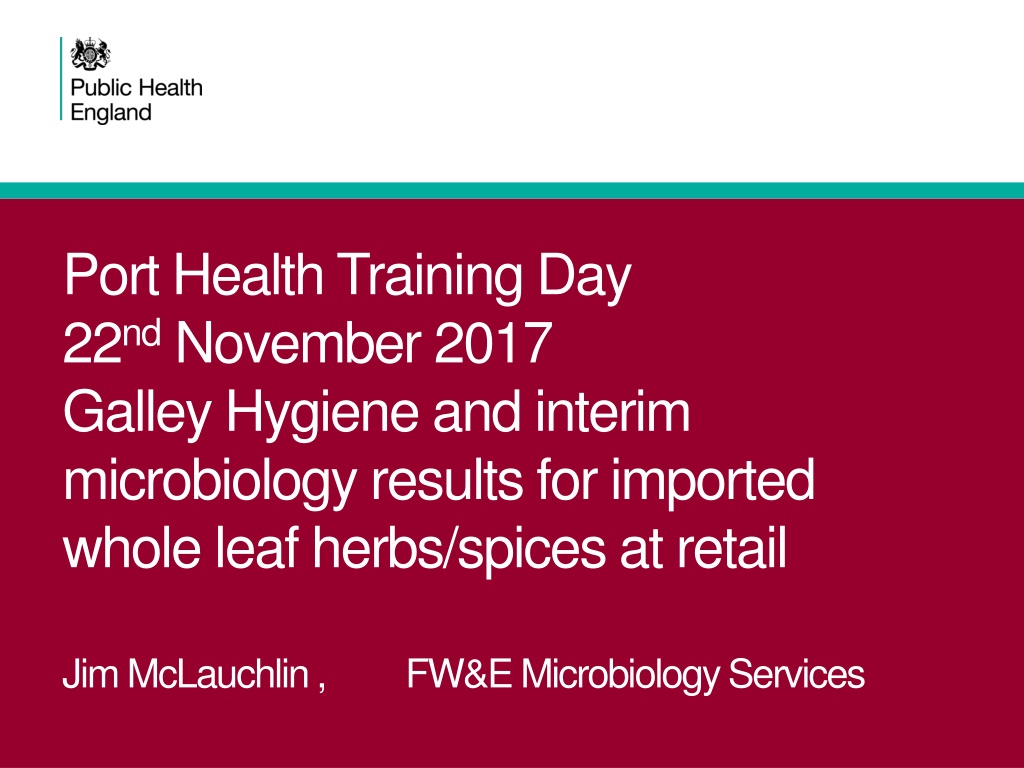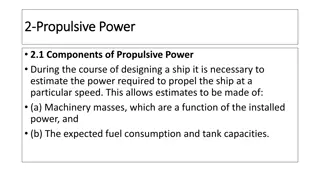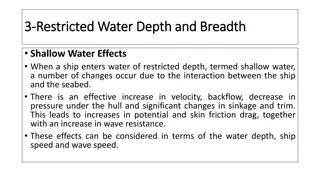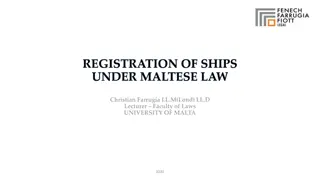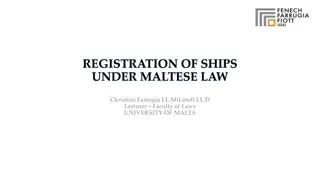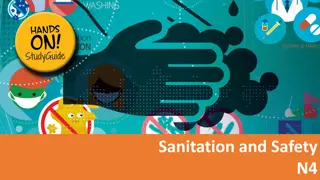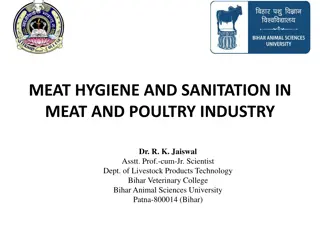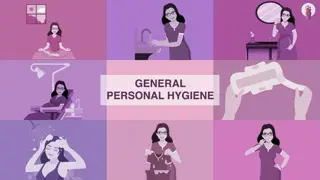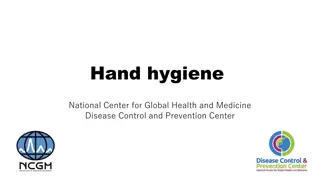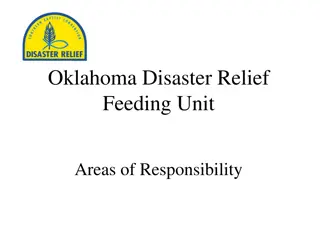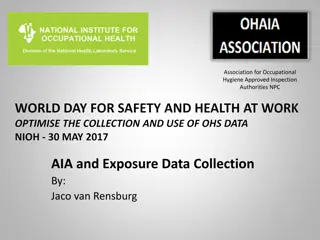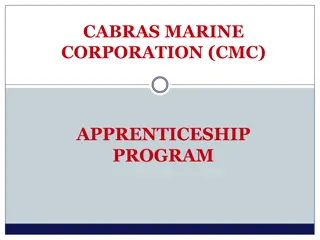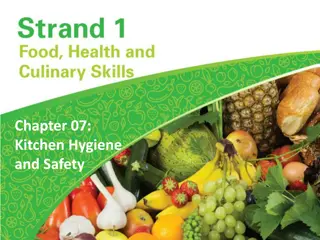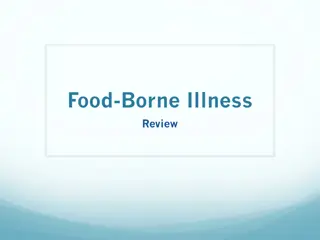Galley Hygiene Survey Findings on Ship Food Safety Standards
In the Port Health Training session on 22nd November 2017, the focus was on galley hygiene and microbiological results for imported herbs/spices at retail. The International Labour Organization's Maritime Labour Convention sets minimum standards for catering departments on ships to ensure nutritious meals in hygienic conditions. Limited information is available on galley hygiene and food quality aboard commercial ships outside of cruise ships. A survey was conducted to sample galleys and assess hygiene practices, revealing data on ship types and satisfaction levels with hygiene standards.
Download Presentation

Please find below an Image/Link to download the presentation.
The content on the website is provided AS IS for your information and personal use only. It may not be sold, licensed, or shared on other websites without obtaining consent from the author. Download presentation by click this link. If you encounter any issues during the download, it is possible that the publisher has removed the file from their server.
E N D
Presentation Transcript
Port Health Training Day 22ndNovember 2017 Galley Hygiene and interim microbiology results for imported whole leaf herbs/spices at retail Jim McLauchlin , FW&E Microbiology Services
Galley hygiene survey The International Labour Organisation s Maritime Labour Convention (2006) states that each Member shall ensure that ships that fly its flag meet the following minimum standards: the organization and equipment of the catering department shall be such as to permit the provision to the seafarers of adequate, varied and nutritious meals prepared and served in hygienic conditions; and catering staff shall be properly trained or instructed for their positions. 2 Port Health Training November 2017
Galley hygiene survey Limited published information regarding galley hygiene or the microbiological quality of food on ships Due to the commercial pressure and the large number of passengers at risk on cruise ships, food hygiene on these ships is generally monitored and well controlled. Hygiene on-board other commercial ships is less well understood. 3 Port Health Training November 2017
Galley hygiene survey Survey was developed to facilitate sampling of galleys in commercial ships other than cruise ships Samples collected between November 2016 and June 2017 by Local Authority and Port Health Authority sampling officers and transported in accordance with the Food Standards Agency Food Law Practice Guidance Officers were asked to take swabs of food preparation surfaces, chopping boards, hand wash sink taps, food preparation sink taps, knife blades, tin opener blades, internal surface of clean mixing bowls and/or internal surface of cleaned food storage containers Samples were examined by PHE Food Water and Environmental Microbiology Laboratories at London, Porton and York 4 Port Health Training November 2017
Galley hygiene survey Data collected using a standard questionnaire 5 Port Health Training November 2017
Galley hygiene survey: Ship type Satisfactory No. (%) Borderline No. (%) Unsatisfactory No. (%) No. of samples Type of Ship 56 (50.5) 0 55 (49.5) Bulk carrier 111 35 (40.7) 2 49 (57.0) Container 86 48 (78.7) 0 13 (21.3) Ferry 61 155 (58.9) 0 108 (41.1) General cargo 263 184 (57.5) 0 136 (42.5) Tanker 320 14 (63.6) 0 8 (36.4) Other 22 41 (46.6) 1 46 (52.2) Not stated 88 533 (56.0) 3 (0.3) 415 (43.6) TOTAL 951 Highest proportion of satisfactory results obtained from ferries 6 Port Health Training November 2017
Galley hygiene survey: overall summary of the microbiology results Satisfactory No. (%) Borderline No. (%) Unsatisfactory No. (%) No. of samples 904 47 951 Type of Ship Swabs Cleaning cloths TOTAL 530 (58%) 3 (6%) 533 (56.0) 3 (0.3%) 0 3 (0.3) 371 (41%) 44 (94%) 415 (43.6) High proportion of unsatisfactory results 7 Port Health Training November 2017
Galley hygiene survey: swabs No. of samples Satisfactory (%) Borderline (%) Unsatisfactory (%) Sampling Point Total 195 118 80 (41.0) 84 (71.2) 85 (51.8) 2 (1.0) N/A 1 (0.6) 113 (57.9) 34 (28.8) 78 (47.6) Chopping board Food container Food preparation surface Handle (door / fridge etc) Knife Slicer Tap Tin opener Utensil Other Not stated Taps, chopping boards and food preparation surfaces least good quality 164 168 66 12 75 36 54 6 10 118 (70.2) 41 (62.1) 7 (58.3) 29 (38.7) 30 (83.3) 46 (85.2) 4 (66.7) 6 (60.0) N/A N/A N/A N/A N/A N/A 0 0 50 (29.8) 25 (37.9) 5 (41.7) 46 (61.3) 6 (16.7) 8 (14.8) 2 (33.3) 4 (40.0) 8 Port Health Training November 2017
Galley hygiene survey: swabs Swabs with template Bacterial counts (cfu per cm2) 1- <10 <102 5 16 <1 10 - 102 - <103 12 103 - <104 8 104 8 3 Aerobic colony count 29 52 50 5 0 2 8 0 0 3 0 0 5 0 0 2 0 0 Enterobacteriaceae E. coli Coagulase positive staphylococci unsatisfactory, borderline 9 Port Health Training November 2017
Galley hygiene survey: swabs Random area swabs Bacterial counts (cfu per swab) 102 -<103103 -<104104 -<105 105 Not applicable 147 87 5 0 15 0 <102 Aerobic colony count Enterobacteriaceae E. coli Coagulase positive staphylococci 511 847 837 61 0 0 46 0 0 unsatisfactory 10 Port Health Training November 2017
Galley hygiene survey: cloths Cleaning cloths Bacterial counts (cfu per cloth) 103 -<104104 -<106106 -<107 107 4 8 0 9 2 1 <103 1 35 43 4 0 0 30 0 1 Enterobacteriaceae E. coli Coagulase positive staphylococci L.monocytogenes 47 0 0 0 0 Listeria species 44 0 3 0 0 unsatisfactory 11 Port Health Training November 2017
Comparison with studies of microbiological quality in mobile vendors Study % Satisfactory Swabs Cloths Mobile Vendors 2006 46 13 Large Events 2009 62 29 Large Events 2010 68 44 Galley Hygiene 2016 58 6 12 Port Health Training November 2017
Galley hygiene survey: Conclusions Study represents hitherto unavailable data More than a third of surfaces swabbed were of an unsatisfactory microbiological quality, with chopping boards, taps, food preparation surfaces and cleaning cloths being a particular concern in terms of cross-contamination risk. Galley hygiene on ferries was better than for non-passenger ships. This may reflect an increased regime of inspections by Port Health Officers or other food safety consultants due to the larger number of people at risk on these ships. Some similarities with microbiological quality of land based mobile vendors, however further analysis ongoing to compared hygiene with other land based food preparation settings 13 Port Health Training November 2017
Galley survey: future actions Complete report and place in public domain Continued gather of an evidence basis to interpret results of environmental sampling: Guidelines in preparation Need for comparisons with other land based land based food preparation settings Need for advice on whether any action should (or can) be taken on unsatisfactory swabs. Ship has usually departed before the results are known, so the Port Health officers have difficulty knowing what to do with a failure that gets reported later. Hygiene failure usually of low risk, and some advice sent on to the shipping company on improving hygiene may be sufficient. Keen to get feedback on the need to produce simple guidance that inspectors can give to ships staff when inspecting galleys to help improve hygiene in future 14 Port Health Training November 2017
Fresh imported leaves Betel leaves Ready-to-eat food most commonly identified as contaminated with Salmonella with contamination rates higher than other similar products Curry leaves Street spice outbreak 2014 Presented data at point of import at PH training day in 2016 15 Port Health Training November 2017
Fresh imported whole leaves sampled at retail: Study duration April-December 2017 Interim results on 241 samples (April Oct) Leaf type banana curry betel Other & NK Total Fresh Frozen Dried 54 106 66 15 30 101 66 15 24 4 0 0 0 1 0 0 Other = vine, mango, pandane, karanja, kaffir, patra 16 Port Health Training November 2017
Fresh imported whole leaves sampled at retail: April-October 2017 Countries of origin Leaf type India Sri Lanka Thailand Bangladesh Other NK banana curry betel Other & NK 1 4 8 6 31 1 2 0 0 1 8 4 7 10 40 21 23 16 4 4 2 0 4 1 17 Port Health Training November 2017
Fresh imported leaves at retail Salmonella detected E. coli enumeration Borderline Satisfactory Unsatisfactory banana curry betel Other & NK 3 (6%) 31(29%) 12 (18%) 2 (13%) 26 (48%) 14 (13%) 15 (22%) 6 (40%) 16 (30%) 46 (43%) 41 (62%) 4 (26%) 12 (22%) 46 (43%) 10 (15%) 5 (33%) All types of leaves can be contaminated with Salmonella Curry leaves, least good microbiological quality Microbiological quality significantly reduced in Sept-Oct after monsoon Association between levels of E.coli and presence of Salmonella 18 Port Health Training November 2017
Import restrictions for fresh leaves Restrictions on the import of curry leaves Fresh curry leaves can only be imported from countries able to fulfil the requirements of the EU import regulations. This includes the need to originate from countries recognised as free of citrus greening disease. Currently there are no countries that have satisfied this requirement and so fresh curry leaves are not permitted to be imported into the EU. If curry leaves are imported they must be either frozen or dried at time of import (https://www.gov.uk/guidance/protecting-plant-health-topical-issues) Paan leaves from Bangladesh 2014 EU Commission implemented a temporary suspension of imported betel leaves originating or consigned by Bangladesh (Decision 2014/88/EU) which was extended in June 2015 (Commission Implementing Decision 2014/510/EU) and then to June 2018 (FSA 2016). 19 Port Health Training November 2017
Fresh imported leaves at retail: conclusions Study ongoing and will have two more months of sampling and testing Curry leaves, least good microbiological quality Similar occurrence of Salmonella contamination in betel leaves between import and retail Microbiological quality significantly reduced in Sept-Oct after monsoon Association between levels of E.coli and presence of Salmonella Not clear if fresh curry leaves have been pre-frozen 1 sample of paan leaves were identified as from Bangladesh which is subject to restrictions and should not be imported into the UK Information on country of origin, durability and intended information often absent 20 Port Health Training November 2017
